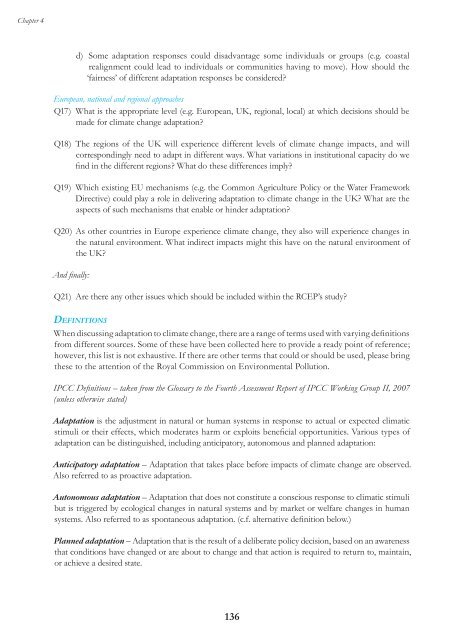Twenty-eighth Report Adapting Institutions to Climate Change Cm ...
Twenty-eighth Report Adapting Institutions to Climate Change Cm ...
Twenty-eighth Report Adapting Institutions to Climate Change Cm ...
You also want an ePaper? Increase the reach of your titles
YUMPU automatically turns print PDFs into web optimized ePapers that Google loves.
Chapter 4<br />
d) Some adaptation responses could disadvantage some individuals or groups (e.g. coastal<br />
realignment could lead <strong>to</strong> individuals or communities having <strong>to</strong> move). How should the<br />
‘fairness’ of different adaptation responses be considered?<br />
European, national and regional approaches<br />
Q17) What is the appropriate level (e.g. European, UK, regional, local) at which decisions should be<br />
made for climate change adaptation?<br />
Q18) The regions of the UK will experience different levels of climate change impacts, and will<br />
correspondingly need <strong>to</strong> adapt in different ways. What variations in institutional capacity do we<br />
find in the different regions? What do these differences imply?<br />
Q19) Which existing EU mechanisms (e.g. the Common Agriculture Policy or the Water Framework<br />
Directive) could play a role in delivering adaptation <strong>to</strong> climate change in the UK? What are the<br />
aspects of such mechanisms that enable or hinder adaptation?<br />
Q20) As other countries in Europe experience climate change, they also will experience changes in<br />
the natural environment. What indirect impacts might this have on the natural environment of<br />
the UK?<br />
And finally:<br />
Q21) Are there any other issues which should be included within the RCEP’s study?<br />
DEFINITIONS<br />
When discussing adaptation <strong>to</strong> climate change, there are a range of terms used with varying definitions<br />
from different sources. Some of these have been collected here <strong>to</strong> provide a ready point of reference;<br />
however, this list is not exhaustive. If there are other terms that could or should be used, please bring<br />
these <strong>to</strong> the attention of the Royal Commission on Environmental Pollution.<br />
IPCC Definitions – taken from the Glossary <strong>to</strong> the Fourth Assessment <strong>Report</strong> of IPCC Working Group II, 2007<br />
(unless otherwise stated)<br />
Adaptation is the adjustment in natural or human systems in response <strong>to</strong> actual or expected climatic<br />
stimuli or their effects, which moderates harm or exploits beneficial opportunities. Various types of<br />
adaptation can be distinguished, including anticipa<strong>to</strong>ry, au<strong>to</strong>nomous and planned adaptation:<br />
Anticipa<strong>to</strong>ry adaptation – Adaptation that takes place before impacts of climate change are observed.<br />
Also referred <strong>to</strong> as proactive adaptation.<br />
Au<strong>to</strong>nomous adaptation – Adaptation that does not constitute a conscious response <strong>to</strong> climatic stimuli<br />
but is triggered by ecological changes in natural systems and by market or welfare changes in human<br />
systems. Also referred <strong>to</strong> as spontaneous adaptation. (c.f. alternative definition below.)<br />
Planned adaptation – Adaptation that is the result of a deliberate policy decision, based on an awareness<br />
that conditions have changed or are about <strong>to</strong> change and that action is required <strong>to</strong> return <strong>to</strong>, maintain,<br />
or achieve a desired state.<br />
136
















